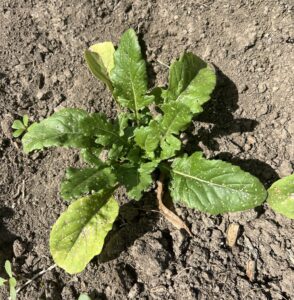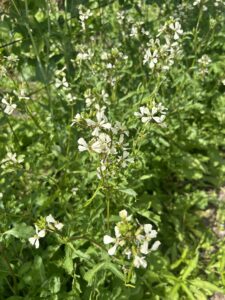More to Explore
When you make a purchase from Seed Savers Exchange, you help fulfill our nonprofit mission to protect our food and garden heritage.

Arugula grows well in the spring and fall but tends to bolt in hot weather. Its prolific flowers attract many pollinators before plants go to seed. Gardeners enjoy this cool-weather crop for its nutty and peppery bite.

Arugula is traditionally direct-sown in the spring after the danger of hard frost has passed or in cooler fall months once soil temperatures start to decline.
Sow shallowly, ¼ inch, in rows and thin to 10 inches between plants.
7-10 days. Arugula will also self-seed in many regions.
Arugula bolts in hot weather. Plant arugula early in the spring or later in the summer for a fall harvest. Successive plantings extend the harvest season. When growing for seed, arugula should be sown so that plants have enough time to produce a healthy canopy of leaves before high temperatures trigger flowering.

Flea beetles are a common pest. To prevent predation, protect plants with row cover.
You can also use castile soap or neem oil to help get rid of flea beetles. Dilute castile soap or neem oil in water and spray it on the leaves. Spray after the sun sets or rinse the solution off with water to avoid sunburn.
You can begin harvesting arugula greens as soon as seedlings emerge in your garden. Many people eat arugula sprouts when thinning plants. Arugula leaves can be selectively picked from the plants periodically throughout the season or entire plants can be harvested.
Arugula is commonly eaten as a fresh salad green or as a peppery addition to sandwiches, pizza, and pasta dishes.
Arugula greens can be stored in the refrigerator for 7-10 days. If you want to preserve these spicy greens, try your hand at making arugula pesto or salsa verde.
Annual
Separate varieties by 800 feet to ½ mile.
To ensure viable seeds, save seeds from at least 5 arugula plants. When maintaining a variety over many generations, save seeds from 20-50 plants. If you’re saving seeds for genetic preservation of a rare variety, save seeds from 80 plants.

The seed heads of arugula will turn light brown and become brittle at maturity.
When most seed heads have matured, seed stalks can be cut and piled onto row cover or landscape fabric in a location protected from rain to finish maturing and drying. The harvested stalks should be dried until the seeds become too hard to dent with a fingernail.
Arugula seeds can be threshed by placing branches on a tarp or in a large container and treading on them, or by rubbing seed stalks together between one’s hands. If the pods are dry, they will release their seeds easily. Seeds can be further cleaned by screening and winnowing.
When stored in cool, dark, dry conditions, arugula seeds can be expected to remain viable for six years.
Read more about storing seeds.
More to Explore
When you make a purchase from Seed Savers Exchange, you help fulfill our nonprofit mission to protect our food and garden heritage.